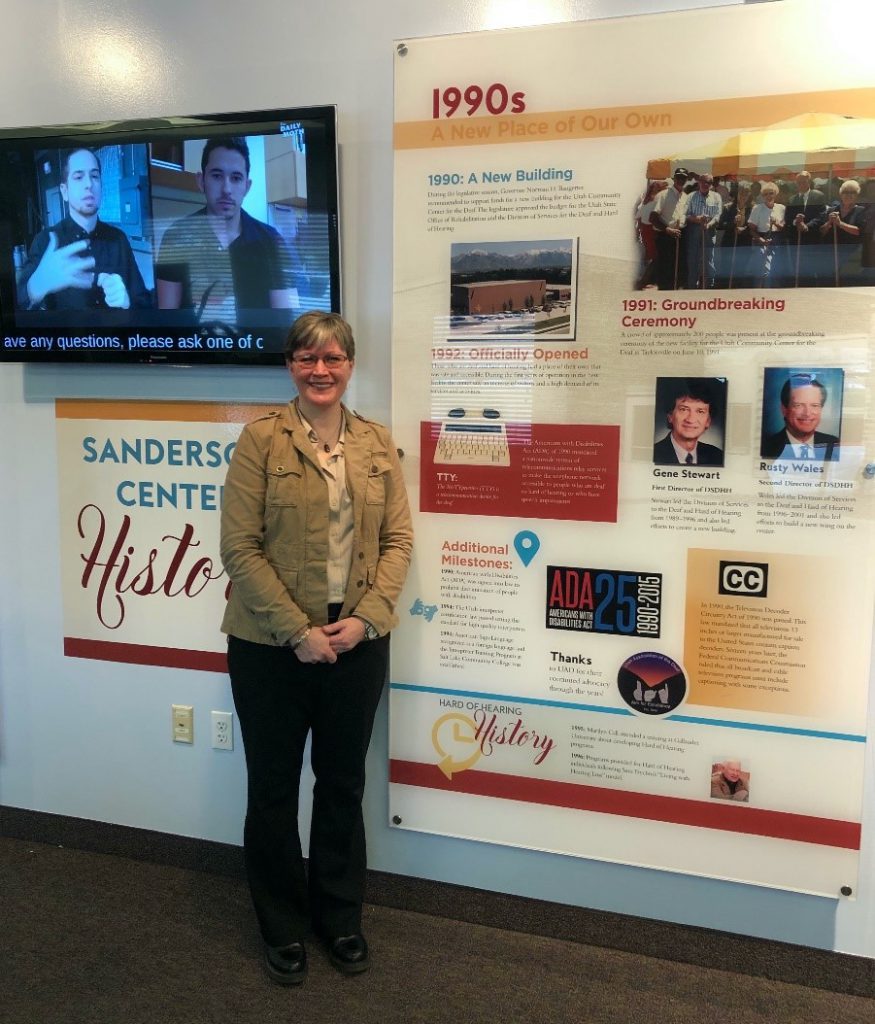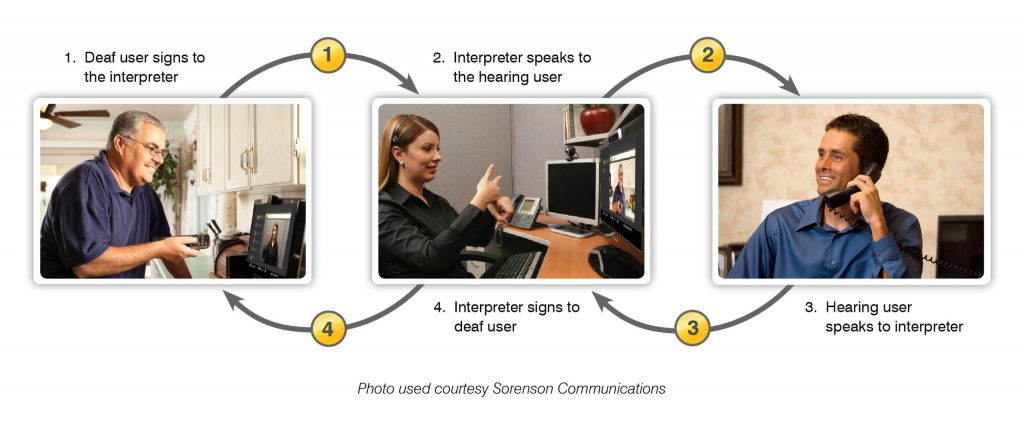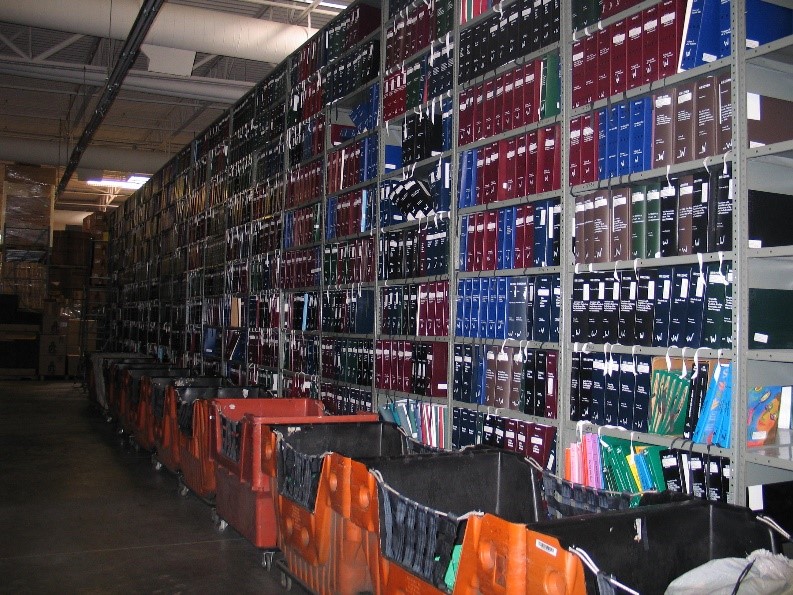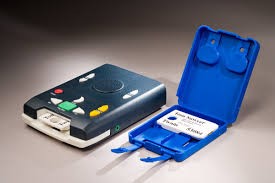By T. Michelle Tucker, Utah State History Volunteer
On July 26, 2020, our nation remembers the passage of the Americans with Disabilities Act (ADA), signed into law by President George H.W. Bush thirty years ago. This is a year to commemorate the long fight of people with (dis)abilities to claim their rights to access. (In the photo above, President George H.W. Bush signs the Americans with Disabilities Act into Law in 1990. Photo courtesy of Wikimedia.)
Utahns with mobility (dis)abilities, those who are Deaf or Hard of Hearing, and those who are Blind or have low vision, are people first. They are able. They just need access, whether it is curb cuts in the sidewalks, an accessible parking spot, auditory signals at traffic lights, sign language interpreter(s), or large print.[1] Accommodations allow people with (dis)abilities to access public places, to access information, work efficiently, and live independently.
For nearly a century, Utah has led the way in accessible books for the Blind. Senator Reed Smoot from Utah coauthored federal legislation to create a library service for Blind adults, and Congress passed the Pratt-Smoot Act in 1930. Utah made great strides in services for the (dis)abled with the establishment of the Utah State Library for the Blind and Disabled in 1931. Today the library provides books that are in braille, large print, and digital talking books with a machine at no cost. They serve twenty-one states with braille books and three states with digital talking books.[2] More recently, the library extended its services to physically challenged people who are not able to hold a book, and people who have Dyslexia.
In 1989 Utah Senator Orrin G. Hatch played a significant role supporting legislation on behalf of people with (dis)abilities.[3] Passage of the ADA in 1990 was a landmark event that culminated years of activism to remove barriers to equal access. The ADA was the most inclusive and far-reaching federal law for the rights of people with (dis)abilities to date.[4] The law requires public agencies and employers with over ten employees to provide reasonable accommodations. Americans with (dis)abilities now have access with curb cuts, ramps, lowered piers, counters, and tables, and bathroom facilities at the right height to aid mobility and use by people in wheelchairs. For the visually impaired, accommodations include materials in braille, digital talking books, and large print books to read. For the Deaf and Hard of Hearing, visual strobe fire alarms are needed. Any entity receiving federal or state funding are required to provide communication access through providing sign language interpreter(s)for the Deaf and Hard of Hearing. The ADA ensured protection from discrimination and introduced new regulations to establish access as a fundamental right for people with (dis)abilities.
The ADA as later amended guaranteed equal opportunity for individuals with (dis)abilities in public health and welfare, employment, public services, access to public transportation or paratransit, public accommodations and services operated by private entities.[5]
In 2003, Utah’s Disability Law Center filed a lawsuit against the Utah Department of Transportation (UDOT) regarding access issues.[6] This case ensured that the state government abide by the American with Disabilities Act. In response, UDOT developed and implemented its Public Right-of-Way Accessibility Transition Plan in 2014.[7] Streets and sidewalks were made more accessible to people with physical (dis)abilities.
Self-Advocacy
The term Deaf is a cultural concept reflecting Deaf people’s connectedness. For the Deaf and Hard of Hearing, language and communication are the keys to access. The lack of captioning, subtitles, sign language interpreters, and other visual information have been society’s barriers. The parts of the ADA that helped this community are largely related to telecommunications. The ADA mandated a nationwide network that provided teletypewriter (TTY) relay and closed-captioning of public service announcements.[8] Sign language interpretation and captioning overcome communication barriers and provide access to people who are Deaf and Hard of Hearing.

Photo credit: author
In 1994, Utah passed an important milestone with passage of its interpreter certification law (SB 41), making it the first state to require sign language interpreters to be certified. This set a high standard for quality that became a benchmark for other states. In an interview conducted in American Sign Language (ASL), Deaf community historian Jodi Becker Kinner explained how Utah has seen significant improvement in the rights of Deaf adults and Deaf children, including another 1994 law that recognized ASL as a foreign language.[9]
As a Deaf person and a parent of Deaf children, Kinner has been instrumental as an advocate for the rights of the Deaf in Utah. She observed that since 1994 Utah’s Deaf and Hard of Hearing community has accomplished several milestones. In 1997 Utah held the first Regional Bilingual/Bicultural Conference for parents of Deaf children, Deaf adults, teachers, and administrators. Also in 1997, at the Utah Association of the Deaf Biennial Conference, Minnie Mae Wilding-Diaz, chair of the Bilingual/Bicultural Committee, urged the Utah School for the Deaf to implement an ASL/English Bilingual program at their school. These advocates fought for many years until they succeeded.
“Minnie Mae Wilding-Diaz along with Utah Deaf Education and Literacy, Inc., helped establish a new charter school named Jean Massieu School (JMS) of the Deaf in 1999,” Kinner stated. “Six years later, in 2006, Utah School for the Deaf agreed to merge with JMS to give parents and students additional educational options.” Despite this merger, another barrier arose for Deaf students — “making the future of the Deaf and Hard of Hearing students ride on a single test,” Kinner said. Under the Utah Deaf school’s regulations, if a student scored an 85 or above on their academic tests, they were required to transfer from Utah Schools for the Deaf and Blind (USDB) into a mainstreamed classroom setting, with or without the use of an interpreter, regardless of the parents’ or child’s decision. In 2007, Kinner served on the newly established USDB Legislative Workgroup to change the law, allowing students who were at-or-above grade level, in addition to the other students, to remain at USDB. In 2009, the Utah legislature passed HB 296 which ensured educational choice for Deaf and Hard of Hearing students.
Kinner uses a parallel with J.K. Rowling’s school for wizards to illustrate the reason Deaf and Hard of Hearing children who sign and are immersed in Deaf culture need to attend USDB. Harry Potter did not feel comfortable with his non-wizard uncle, aunt, and cousin, and did not fit in with the other students in the Muggle school.[10] But Harry reached his full potential at Hogwarts, a school for wizard children. So too with the Deaf and Hard of Hearing who flourish at their own school.[11] “The advantages a school of the Deaf possesses are direct communication, school time with like peers, Deaf and Hard of Hearing culture and identity, and Deaf role models. The education at a school of the Deaf would be ASL/English Bilingual, having the goal for ASL and English to be equal in the literacy of Deaf children,” Kinner said.
Another milestone for Utah’s Deaf community came in 2017. Before this time, the term used for Deaf and Hard of Hearing legislation in Utah had been “hearing impaired,” language that suggested Deaf people are broken, inferior, and not able. “It is very negative,” said Kinner. The Utah Association of the Deaf supported HB 60 in the 2017 legislative session, which replaced this negative language with the term Deaf and Hard of Hearing. Kinner said, “It passed and Governor Gary Herbert signed the bill. I was also there to witness him signing the change. That was a huge impact on the history of the Deaf for Utah to use the positive term Deaf and Hard of Hearing.”[12]
In 2003, a Utah company, Sorenson Media (now Sorenson Communications), was established to provide accessible phone telecommunications for the Deaf and Hard of Hearing. Sorenson Communications is the leader in video relay services (VRS) and VRS equipment. Caption Call, another Utah branch of Sorenson, provides captioned telecommunication services to a variety of people with hearing difficulties. These events and telecommunication services have greatly advanced the equal access of Deaf and Hard of Hearing people to education and communication.

Sports Abilities
In 2002, Utah hosted the first Winter Paralympics in the United States. The opening ceremonies were held in Rice-Eccles Stadium in Salt Lake City, the same location of the February 2002 Winter Olympics. Sledge hockey teams played in the Utah Olympic Oval. Athletes who were in the 2002 Winter Paralympic Games in Utah broke a barrier. Winter 2002 was the first time in the United States when the Paralympic athletes won the right to compete in a Winter games in the United States. To top it off, Team USA won the Paralympic sled hockey gold medal. Utah also hosted the Deaflympics Winter games in 2007, which was the second time the Deaf and Hard of Hearing competed in a Winter games in the United States. More recently, the University of Utah School of Mechanical Engineering students have designed an adaptive sled for a Utah Paralympic athletes to zoom over the snow faster than ever before for the next Winter Paralympics.[13]

Courtesy Utah State Historical Society.
Utah also supports people with autism through several organizations. The Utah Parent Center provides resources and family support, and the Melisa Nellesen Center for Autism educates college-aged adults with high-functioning autism. In 2020, Utah broke ground for a new resource center, The Pingree Center for Autism in Murray for adults with severe autism.
In the long history of discrimination against people with (dis)abilities, the last thirty years have been brighter. Utah provides a range of services and programs for parents, children, families, and adults with (dis)abilities. People with (dis)abilities receive an equal education, work in their jobs, and have better quality of life. More persons with (dis)abilities have themselves advocated for laws for their rights. As a result, accessibility laws in the state of Utah, in addition to the ADA, have been milestones on the road towards equal access for all.
Notes
1. Americans with Disabilities Act 1990, as amended. “ADA Statute,” accessed March 3, 2020, https://www.ada.gov/pubs/adastatute08.htm.
2. Lisa Nelson, Program Manager, Regional Library for the Blind, Utah State Library for the Blind and Disabled Interview by author, Utah, May 14, 2020.
3. US Congress, “Member Orrin G. Hatch”, accessed on March 3, 2020, https://www.congress.gov/member/orrin-hatch/H000338?q={%22subject%22:%22Civil+Rights+and+Liberties,+Minority+Issues%22}&searchResultViewType=expanded&KWICView=false.
4. American with Disabilities Act of 1990, as amended, “ADA Statute,” accessed March 3 and March 9, 2020, https://www.ada.gov/pubs/adastatute08.htm.
5. Ibid.
6. Disability Law Center. “Our History”, accessed March 3 and March 9, 2020. http://disabilitylawcenter.org/history/.
7. UDOT, Public Right-of-Way Accessibility Transition Plan – Americans with
Disabilities Act, December 2014 Update, accessed March 9, 2020,
8. American with Disabilities Act of 1990, as amended, accessed
March 3 and March 9, 2020, https://www.ada.gov/pubs/adastatute08.htm.
9. In-person Interview with Jodi Becker Kinner on March 9, 2002 at the Sanderson Community Center for the Deaf and Hard of Hearing. Kinner is the author of several articles on Utah Deaf History by author.
10. Kinner.
11. Todd A. Czubek, “Understanding Harry Potter: Parallels to the Deaf World, Journal of Deaf Studies and Deaf Education, 10, no. 4(Fall 2005):442-450.
12. Kinner.
13. Mike Gorell, “University of Utah Mechanical Engineers Teamed Up to Give Paralympic Cross Country Skier a Shot at Gold,” Salt Lake Tribune, March 15, 2018.
Bibliography
Americans with Disabilities Act 1990, as amended. “ADA Statute,” accessed March 3
2020. https://www.ada.gov/pubs/adastatute08.htm.
Czubek, Todd A. “Understanding Harry Potter: Parallels to the Deaf World. Journal of Deaf
Studies and Deaf Education. Vol.10. No. 4(Fall 2005):442-450.
Disability Law Center. “Our History”, accessed March 3 and March 9, 2020.
Gorell, Mike. “University of Utah Mechanical Engineers Teamed Up to Give
Paralympic Cross Country Skier a Shot at Gold.” Salt Lake Tribune, March 15,
2018.
Kinner, Jodi Becker Kinner. Interview by T. Michelle Tucker on March 9, 2002 at the Sanderson
Community Center for the Deaf and Hard of Hearing.
Kinner, Jodi Becker. A Brief History of the Utah Association of the Deaf. Utah
Deaf History. 2012. Accessed March 2 and March 9, 2020.
Kinner, Jodi Becker. Controversies Surrounding Communication/Educational Methods
and Educational Placement Regarding the Interpretation of ‘Least Restrictive
Environment’ in Utah, Part III. 2016. Accessed March 9, 2020. https://www.utahdeafhistory.com/uploads/5/4/2/6/5426987/part_iii-
controversies_surrounding_communication-educational_methods_.pdf.
Kinner, Jodi Becker. The Evolution of Deaf Education in Utah. Utah Deaf History,
2006-2019. Accessed March 9, 2020. https://www.utahdeafhistory.com/deaf-education-in-utah.html
Kinner, Jodi Becker, In Danger: Deaf Education in Utah, Part V In Danger: Deaf
Education in Utah and Its Impact on ASL/English Bilingual Program as well as
Inequality of Deaf Education in Utah, 2019, accessed March 9, 2020.
5/4/2/6/5426987/part_v_-_in_danger_deaf_education_in_utah.pdf
Nelson, Lisa. Program Manager. Regional Library for the Blind, Utah State Library
for the Blind and Disabled Interview by author. Utah. May 14, 2020.
Interview by T. Michelle Tucker.
UDOT, Public Right-of-Way Accessibility Transition Plan – Americans with
Disabilities Act, December 2014 Update. Accessed March 9, 2020.
United States Congress. “Member Orrin G. Hatch.” Accessed on March 3, 2020.



